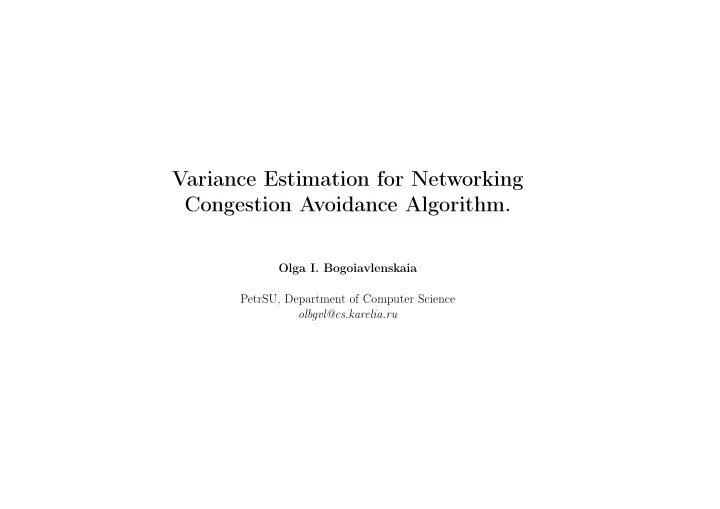

Variance Estimation for Networking Congestion Avoidance Algorithm. Olga I. Bogoiavlenskaia PetrSU, Department of Computer Science olbgvl@cs.karelia.ru
TCP Congestion Control • The paradigm of Distributed Control in Packet Switching Network • Transmission Control Program, 1974. • Congestion collapse • Variance not important yet 1
S. Low tree 2
Example of Tahoe Trajectory 3
TCP Congestion Control Development • Jitter sensitive applications • TCP vs UDP • High BDP links utilization vs Congestion Control • Best effort vs QoS guarantees 4
Variety of Experimental Versions • TCP CUBIC - cubical growth period. RTT independent • High Speed TCP (HSTCP), S. Floyd 2003. Congestion Avoidance coeff. of linear growth and multiplicative decrease are convex functions of current window size • Scalable TCP (STCP) T. Kelly, 2003. Decreases time of data recovery • H-TCP, Hamilton Institute, Ireland, 2004. Intended for links with high BDP value. Uses RTT size to react on losses • TCP Hybla 2003-04. Developed for satellite links. Scales throughput to mimic NewReno and utilize link at the same time. 5
Variety of Experimental Versions • TCP Westwood, 2001. Tries to identify the reason behind losses. Developed for wireless links. • TCP-Illinois uses dynamic function for defining Congestion Avoidance parameters • TCP-LP (Low Priority) • TCP-YeAH 6
TCP Variance • Why important? • A lot of models of average window size — Reno, NewReno, CUBIC • Asymptotic studies etc. D. Towsley group for p > 0 . 025 MSS T = (1) � � 2 p 3 p 8 ) p (1 + 32 p 2 ) 3 + RTOmin (1 , 3 RTT 7
TCP NewReno ’Saw’ w(t) w i+1 w i α ’triple−duplicate’ periods w τ τ t td i−1 td td i i+1 i i+1 8
Variance evaluation • Altman E., Avrachenkov K., Barakat C. A Stochastic model of TCP/IP with Stationary Random Losses, Proceedings of ACM SIGCOMM’00. Stockholm, 2000. pp. 231-242. • Some ‘popular’ assumptions provide difficulties in estimating TCP variance, e.g. • Variance is V ar [ X ] = E [ X 2 ] − ( E [ X ] 2 ) • Root square lows are derived thorough Goelders’s inequality i.e. � E [ X 2 ] E [ X ] ≤ 9
Variance estimation • Using geometrical considerations one get from TCP ‘saw’ X 2 n +1 = αX 2 n + 2 bS n , • Expanding, one gets n X 2 α 2 i S k + n − i � k + n = 2 b i =0 or � n α 2 i S k + n − i � • X k + n = 2 b i =0 10
Variance estimation � n n √ � �� � � � � α 2 i S k + n − i α 2 i S k + n − i ≤ E [ X k + n ] = E � 2 b 2 b E i =0 i =0 Now when n → ∞ one gets the following n √ �� � � α 2 i S i E [ X ] = lim n →∞ E [ X n ] ≤ lim 2 b = E i =0 √ 2 b � 1 − αE [ S n ] For b = 1 and α = 1 2 and hence √ � E [ X ] ≤ 2 2 E [ S n ] 11
Variance evaluation Now we have two estimations of sliding window size expectation � 8 3 E [ S 2 • E [ X ] ≤ A = n ] √ 2 E [ √ S n ] • E [ X ] ≤ B = 2 Reminder. If B < A then it could be used for estimation variance V ar [ X ] ≤ A 2 − B 2 . This holds if � E [ S n ] � E [ S n ] < . 3 12
Variance evaluation. Examples Lets p.d.f. of S n is F ( x ) = 1 − e λx then E [ S n ] = 1 λ and √ π � 1 � E [ S n ] = λ. 2 Condition does not hold. 13
Variance evaluation. Examples. Lets p.d.f of S n is Pierson root square distribution then its moments can be calculated through Γ -function and 2 Γ( n +1 2 ) 1 E [ S n ] = 2 Γ( n 2 ) and 4 Γ( 2 n +1 4 ) 1 � E [ S n ] = 2 2 ) . Γ( n The result depends on parameter n. Condition holds for e.g. n = 10 . 14
Variance evaluation Notice that n →∞ E [ X 2 n →∞ E [ X 2 lim n ] = lim n +1 ] and n ] = 2 bE [ S n ] n →∞ E [ X 2 lim 1 − α 2 . Hence there might take place � 2 b � n →∞ E [ X n ] = lim 1 − α 2 E [ S n ] . GetTCP kernel level monitor for OS Linux 15
Conclusion • The Development of Congestion Control schemes is considered • The importance of TCP variance evaluation is demonstrated • Possible approaches to the problem are analyzed • Variance estimation is proposed 16
Recommend
More recommend